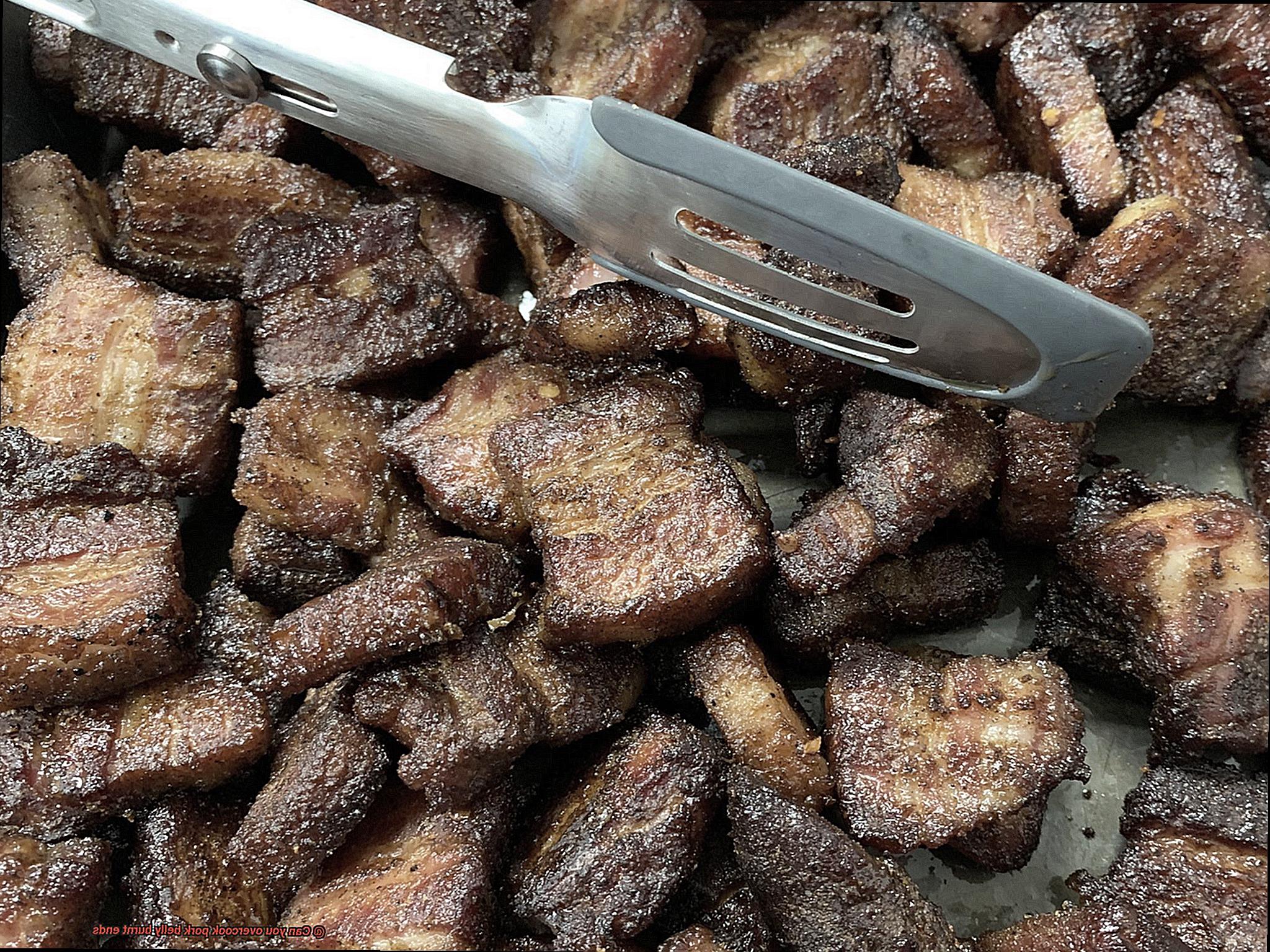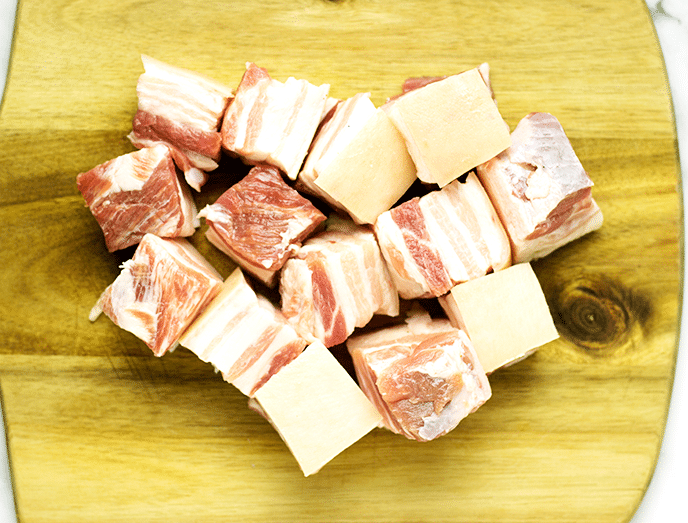Smoked pork belly is one of my favorite foods to prepare. This was one of the first foods my wife and I worked on when I first tried to teach her how to smoke right. Although we can’t decide who makes this better, we both agree that it tastes delicious.
Today, you will learn how to make this recipe yourself. It takes a few hours to prepare but it’s well worth the effort. Making this for dinner is easiest if you start around lunchtime. That way, everything will be ready when dinner time comes around.
Pork belly is a cut of meat that has risen in popularity for its rich, fatty, and tender texture when cooked properly This fatty cut needs special care when cooking to avoid overcooking, which can result in dry, tough, chewy meat So can you overcook pork belly? The short answer is yes.
When braised roasted, smoked or otherwise cooked for too long at too high of temperature, pork belly can go from succulent to rubbery. Overcooking causes the fat to render out completely and the meat fibers to toughen. Thankfully, there are ways to ensure moist tender pork belly every time.
In this comprehensive guide we’ll cover the keys to preventing overcooked pork belly signs to look for when it’s overdone, the best cooking methods, and tips to nail it perfectly every time. Let’s get cooking!
Can You Overcook Pork Belly?
Yes, it is definitely possible to overcook pork belly. This cut contains a high ratio of fat, which needs ample time to melt and tenderize the meat when cooked properly. However, going overboard with cooking time or temperature can cause the fat to render out completely, leaving behind dry, rubbery meat.
Once the pork belly reaches optimal tenderness and the fat has fully rendered, continuing to cook it will draw out all the moisture. The meat fibers will shrink and toughen up without the lubricating fat. So it’s essential to avoid overcooking by using the right methods and keeping close watch throughout cooking.
Signs Your Pork Belly is Overcooked
It’s important to keep an eye out for signs of overcooked pork belly:
- Dry, rubbery, tough to chew texture
- Meat fibers are shriveled and stringy
- Fat has rendered out completely
- Dark brown or burnt exterior
- Flavor is bland and dry
The pork should shred easily and melt in your mouth when optimally cooked. If it seems tough and chewy or is sticking to your teeth, it’s overcooked. Use these visual and textural cues to determine when to pull it off the heat.
Best Cooking Methods for Pork Belly
To avoid overcooking, use moist cooking methods at lower temperatures:
-
Braising: Partially submerge pork in liquid like broth, wine, or juice. Cover and cook at 300-325°F for 2-3 hours until fork tender.
-
Roasting: Roast in oven at 275-300°F for 2-3 hours until deeply browned and tender.
-
Smoking/grilling: Use low indirect heat around 250°F and smoke for 6-8 hours until very tender.
-
Sous vide: Cook vacuum sealed pork belly in water bath at 155-175°F for 12-24 hours depending on thickness.
These gentle cooking methods allow time for fat to render slowly without overdrying the meat.
Tips for Perfectly Cooked Pork Belly Every Time
Follow these handy tips for mouthwatering pork belly:
- Choose a well-marbled cut with ample fat.
- Score the skin before cooking to help render fat.
- Monitor temperature and check often for doneness.
- Cook low and slow – do not rush the process.
- Allow meat to rest before serving.
Take it slow, be patient, and use visual cues like deep caramelization and pork shreds to determine doneness rather than solely relying on temperature. Master these techniques and you’ll be rewarded with the ultimate tender, juicy pork belly every time.
Step-by-Step Method for Braised Pork Belly
This method for braised pork belly exemplifies the keys for optimal texture and flavor:
Ingredients:
- 2 lbs pork belly, skin scored
- 1 onion, diced
- 4 garlic cloves, minced
- 2 cups chicken broth
- 1⁄4 cup soy sauce
- 2 tbsp brown sugar
- 1 tbsp rice vinegar
- 1 tsp freshly ground black pepper
Instructions:
-
Preheat oven to 300°F.
-
Pat pork belly dry and season generously with salt and pepper.
-
Heat oil in ovenproof pan/Dutch oven over medium-high heat. Sear pork belly on both sides until browned. Remove from pan.
-
Add onion and garlic to pan. Sauté 3-5 minutes until softened.
-
Return pork belly to pan along with broth, soy sauce, brown sugar, and vinegar.
-
Bring to a simmer then cover and transfer to oven. Braise for 2-3 hours until very tender.
-
Remove pork from braising liquid and rest 10-15 minutes before serving.
-
Meanwhile, simmer braising liquid until thickened into glaze.
-
Slice pork belly and drizzle with glaze to serve.
This method allows the pork to cook low and slow so the fat renders without overdrying. Be sure to check often for doneness signs like shred-ability.
What to Do If You’ve Overcooked Your Pork Belly
If you notice your pork belly is overcooked, dry out, here are some remedies:
-
Chop or shred pork into smaller pieces to minimize chewiness.
-
Moisten meat by mixing in defatted braising liquids, broths, or sauce.
-
Use pork in wet dishes like stir fries, fried rice, or noodle bowls.
While overcooked pork can’t be reversed, incorporating moisture and cutting into smaller bits can improve the eating experience. Learn for next time and you’ll be rewarded with perfect pork belly.
Achieving succulent, tender pork belly requires patience and the right cooking methods. While it’s possible to overcook this fatty cut, rendering it dry and chewy, a few simple practices will help you avoid this fate. Low, slow moist-heat cooking, monitoring doneness carefully, and resting before serving are keys to pork belly success. Master these techniques and wave goodbye to rubbery meat. With the proper care and cooking, you’ll be able to enjoy rich, melt-in-your-mouth pork belly every time. Now get cooking!

Can you overcook pork belly?
It’s very possible to overcook pork belly. You will know when pork belly is overcooked because the muscle and fat will become rubbery. This is why it’s important to not set the temperature too high and to not cook too long.
Like with making all other foods, patience is key. If you rush the process, the recipe won’t come out as good as it should.
Is pork belly the same as bacon?
While they are both cut from the underside of the pig, there is a difference between the two.
Starting with pork belly, it is the whole slab cut from the belly of the pig. Pork belly is also uncured.
Bacon is also made from pig belly, but not from the same slab as pork belly. Unlike pork belly, bacon is cured or brine. Also, bacon can be made from different parts of the pig, like the back and shoulders.


One of My Favorite Ways To Cook The Mighty Pork Belly
FAQ
Does pork belly get more tender the longer you cook it?
How to tell if pork belly is overcooked?
Does cooking pork belly longer make it softer?
Can you overcook pork belly slices?
How do you know if a pork belly is good?
It should basically melt in your mouth. The fat should be soft and the meat should easily shred. Sorry, Elizabeth, but great pork belly comes to those who wait. Now get in there and belly up. No one should have to put up with pork belly that’s hard to chew. Especially not you.
Can You overcook pork belly?
Yes, it is possible to overcook pork belly, which can result in tough and dry meat. It’s important to monitor the internal temperature of the pork belly and remove it from the oven or grill once it reaches 160-180°F to prevent overcooking.
Is pork belly better cooked at a lower temperature?
However, there are certain things, like pork belly, that are better cooked at lower temperatures for longer periods of time. Meats containing higher fat and collagen are supremely delicious and succulent but require more time to render the fat and melt the collagen. The amount of fat in a pork belly can vary widely.
Does a pork belly need a pressure cooker?
Meats containing higher fat and collagen are supremely delicious and succulent but require more time to render the fat and melt the collagen. The amount of fat in a pork belly can vary widely. A piece with 30 percent fat will take longer to render than a leaner, 20 percent piece. There is really no way to speed that up, even in a pressure cooker.
